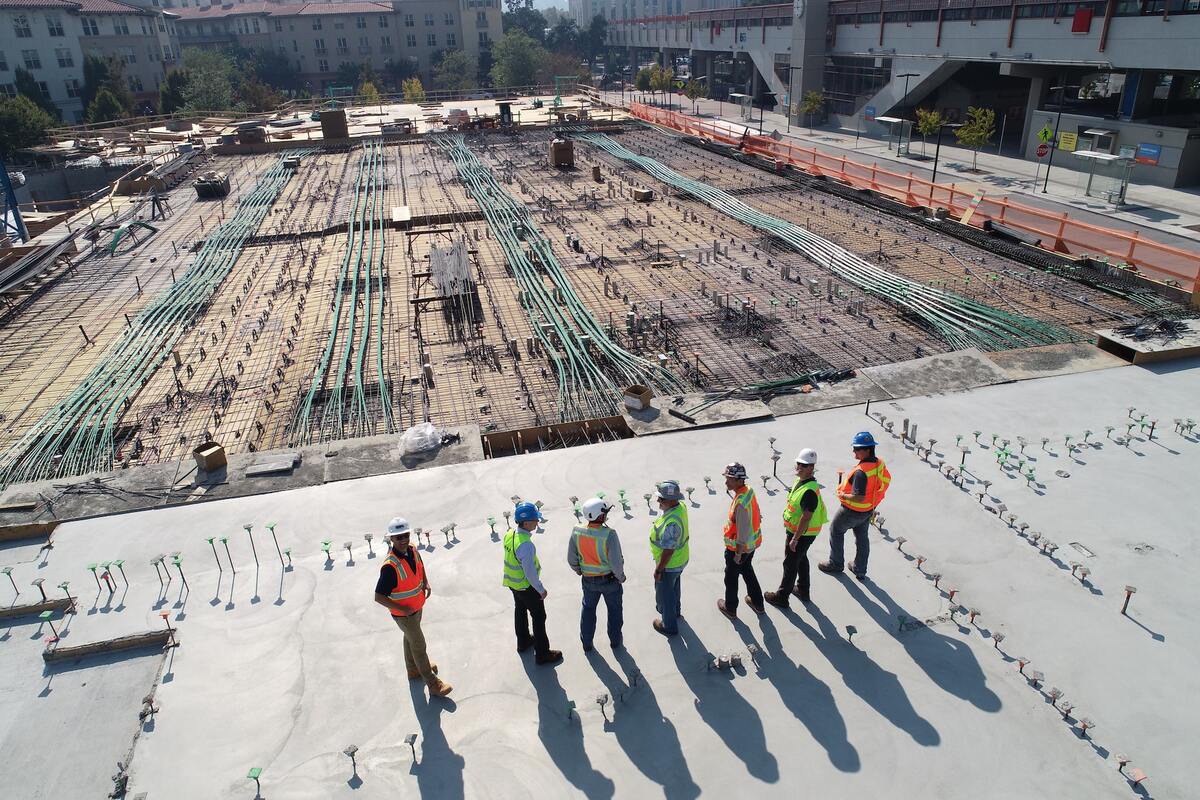Home>diy>Building & Construction>What Is Earned Value In Construction


Building & Construction
What Is Earned Value In Construction
Modified: December 7, 2023
Discover the concept of earned value in building construction, its importance, and how it can optimize project management for maximum efficiency.
(Many of the links in this article redirect to a specific reviewed product. Your purchase of these products through affiliate links helps to generate commission for Storables.com, at no extra cost. Learn more)
Introduction
Welcome to the world of construction, where every project requires careful planning, efficient management, and accurate cost control. In this dynamic industry, staying ahead of the game is crucial to ensure project success and profitability. One essential tool that has revolutionized the construction management process is earned value.
Earned value is a powerful technique that enables project managers to assess project performance, track costs, and measure progress against planned schedules. It provides a comprehensive view of a project’s health, allowing stakeholders to make informed decisions and take corrective actions when necessary.
In the construction industry, where budgets are often tight and timelines are strict, understanding earned value and implementing effective earned value management practices can be the key to delivering projects on time and within budget.
In this article, we will delve into the world of earned value in construction. We will explore its importance, its key components, how to calculate earned value, and the benefits and challenges of using earned value management in construction projects. Additionally, we will provide best practices for utilizing earned value and showcase case studies of successful implementation. So, let’s jump in and discover how earned value can transform the way you manage construction projects!
Key Takeaways:
- Earned value management (EVM) is a game-changer in construction, providing a standardized approach to measure project performance, control costs, and ensure timely project completion. By leveraging EVM, construction professionals can make informed decisions and drive successful outcomes.
- Implementing earned value management in construction projects offers benefits such as accurate performance measurement, early warning for potential issues, improved cost control, better schedule management, enhanced decision-making, and effective stakeholder communication. Embracing EVM practices can lead to optimized resource utilization, proactive risk management, and successful project delivery.
Understanding Earned Value in Construction
Earned value is a project management technique that measures the progress and performance of a project by comparing the value of work performed to the planned value. It provides a clear and objective assessment of a project’s status, allowing project managers to identify any deviations from the original plan and take appropriate corrective actions.
In the context of construction projects, earned value is particularly valuable due to the complex and dynamic nature of the industry. Construction projects often involve multiple tasks, resources, and stakeholders, making it challenging to track progress and manage costs effectively. Earned value helps overcome these challenges by providing a standardized framework for measuring project performance.
At its core, earned value focuses on three key metrics:
- Planned Value (PV): This represents the authorized budget for the work scheduled to be completed at a given point in time. It provides a baseline for measuring project progress.
- Actual Cost (AC): This reflects the actual cost incurred for the work performed up to a specific date. It includes all direct and indirect costs associated with the project, such as labor, materials, and equipment.
- Earned Value (EV): This represents the budgeted value of work completed up to a specific date. It measures the value of work that has been accomplished, taking into account both time and cost.
By analyzing these metrics, project managers can gain valuable insights into the project’s performance. The difference between earned value (EV) and planned value (PV), known as the Schedule Variance (SV), indicates whether the project is ahead or behind schedule. Similarly, the difference between earned value (EV) and actual cost (AC), called the Cost Variance (CV), indicates whether the project is under or over budget.
The analysis of earned value metrics enables project managers and stakeholders to answer critical questions, such as:
- Is the project on track to meet its scheduled completion date?
- Is the project within the allocated budget?
- Are there any cost or schedule overruns?
- What corrective measures need to be taken to bring the project back on track?
In summary, earned value provides a comprehensive and objective view of a construction project’s performance. It enables project managers to monitor progress, control costs, and make informed decisions throughout the project lifecycle. By implementing effective earned value management practices, construction organizations can optimize project outcomes and achieve greater success.
Importance of Earned Value Management
Earned Value Management (EVM) is a powerful tool that plays a vital role in the success of construction projects. It offers a range of benefits that contribute to better project control, improved decision-making, and increased project success rates. Let’s explore the key reasons why earned value management is important in the construction industry.
- Accurate Project Tracking: Earned value provides a standardized and objective method for tracking project progress. By comparing the planned value (PV), actual cost (AC), and earned value (EV), project managers can measure the performance of the project against the established baseline. This allows them to identify any deviations, understand the reasons behind them, and take corrective actions to bring the project back on track.
- Cost Control: Construction projects are often prone to cost overruns, which can have a significant impact on the financial health of the project. By utilizing earned value management, project managers can closely monitor costs and identify early warning signs of potential overruns. They can compare the earned value (EV) to the actual cost (AC) to determine the cost variance (CV) and take proactive measures to mitigate any budgetary issues.
- Improved Schedule Management: Construction projects are time-sensitive, and delays can result in additional costs and penalties. Earned value management allows project managers to evaluate the schedule variance (SV) by comparing the earned value (EV) to the planned value (PV), providing insights into the project’s progress against the established timeline. This enables project teams to identify schedule deviations and implement strategies to manage and mitigate potential delays.
- Risk Identification and Mitigation: Earned value management aids in early identification of risks and potential issues within a project. By comparing the planned value (PV) with the earned value (EV) and actual cost (AC), project managers can spot variations, analyze their causes, and take proactive steps to mitigate risks. This helps in minimizing the impact of risks on project outcomes and ensures timely and successful project delivery.
- Enhanced Communication and Stakeholder Management: Earned value provides a tangible and quantifiable measure of project performance, making it easier for project teams to communicate progress and challenges to stakeholders. By utilizing earned value management techniques, project managers can provide accurate and transparent updates on the project’s health, enabling stakeholders to make informed decisions and maintain confidence in the project’s success.
Overall, earned value management brings transparency, control, and effective decision-making to construction projects. By implementing this technique, project teams can proactively manage costs and schedules, mitigate risks, and ensure successful project delivery. It serves as a valuable tool for project managers, enabling them to stay on top of their projects and deliver results that meet or exceed stakeholder expectations.
Key Components of Earned Value
Understanding the key components of earned value is essential for effective implementation and management of this project management technique. Let’s explore the three fundamental components of earned value: planned value (PV), actual cost (AC), and earned value (EV).
- Planned Value (PV): Also known as the budgeted cost of work scheduled (BCWS), planned value represents the authorized budget for the work planned to be accomplished within a specific timeframe. It is typically established during the project planning phase and serves as the baseline against which performance is measured. The planned value indicates how much value (in terms of cost) should have been earned at a specific point in time, based on the project schedule.
- Actual Cost (AC): The actual cost, also referred to as the actual cost of work performed (ACWP), reflects the total costs incurred for the work that has been completed up to a given date. It includes all direct and indirect costs associated with the project, such as materials, labor, equipment, and overhead expenses. The actual cost provides a clear understanding of the financial resources utilized during the project execution phase.
- Earned Value (EV): Earned value, often called the budgeted cost of work performed (BCWP), represents the value of work that has been completed up to a specific date. It is a measure of the physical progress and accomplishment of the project. The earned value takes into account both the planned value and the actual work completed. It is calculated based on the actual work performed and the value assigned to that work in the project plan.
To illustrate the relationship between these components, let’s consider the following example:
Suppose a construction project has a planned value of $100,000 for the first month. At the end of the month, the actual cost incurred for the work performed is $90,000. The earned value is determined based on the completion percentage of the planned work. If, for instance, the work completed is assessed to be 70% of the planned value, the earned value would be $70,000 (70% of $100,000).
The analysis of these components allows project managers to calculate key performance indicators and assess the project’s current status:
- Schedule Variance (SV) = Earned Value (EV) – Planned Value (PV)
- Cost Variance (CV) = Earned Value (EV) – Actual Cost (AC)
- Schedule Performance Index (SPI) = Earned Value (EV) / Planned Value (PV)
- Cost Performance Index (CPI) = Earned Value (EV) / Actual Cost (AC)
By analyzing these indicators, project managers can identify any deviations from the planned schedule and budget, and take proactive measures to address them. Understanding and effectively utilizing these key components of earned value enables project managers to gain better control over their projects, make informed decisions, and optimize project outcomes.
Calculating Earned Value
Calculating earned value is a crucial step in utilizing earned value management to assess project performance. It involves measuring the value of work that has been accomplished against the planned value and actual cost. Let’s explore the two common methods used to calculate earned value: the 0/100 rule and the percentage complete method.
1. 0/100 Rule: The 0/100 rule is a simple approach that assigns 0% earned value to an activity until it is 100% complete. This method assumes that no value is earned until the entire activity is finished. While the 0/100 rule is easy to apply, it may not accurately reflect the actual progress of the project and can lead to discrepancies if an activity takes longer than expected.
2. Percentage Complete Method: The percentage complete method is a more accurate approach to calculate earned value. It involves assigning a percentage value to each activity, indicating the proportion of work completed. This percentage can be determined based on physical progress, milestones, or expert estimates. The earned value is then calculated as a percentage of the planned value. For example, if an activity with a planned value of $10,000 is 70% complete, the earned value would be $7,000 (70% of $10,000).
Regardless of the method used, understanding the planned value (PV) and the percentage of work completed is essential for calculating earned value. Here’s a formula commonly used to calculate earned value:
Earned Value (EV) = Planned Value (PV) x Percentage Complete
Once the earned value is calculated, it can be compared to the actual cost (AC) to determine the cost variance (CV) and evaluate the project’s financial performance. Similarly, comparing the earned value to the planned value allows for the calculation of the schedule variance (SV) and assesses the project’s progress against the schedule.
It’s important to note that different activities within a project may require different methods for determining the percentage complete. Work closely with your project team and subject matter experts to accurately estimate the progress of each activity and ensure consistency in calculating earned value.
By regularly calculating earned value and analyzing performance metrics, project managers can gain insights into the project’s progress, identify potential issues, and make informed decisions to keep the project on track. Effective calculation and utilization of earned value add a level of precision and control to project management, enabling successful project delivery.
Interpreting Earned Value Results
Interpreting earned value results is a critical step in utilizing earned value management to assess project performance and make informed decisions. The key performance indicators derived from earned value calculations provide valuable insights into the project’s schedule and cost performance. Let’s explore how to interpret earned value results and understand their implications.
1. Schedule Variance (SV): The schedule variance indicates whether the project is behind or ahead of schedule. A positive SV means the project is ahead of schedule, while a negative SV signifies the project is behind schedule. An SV of zero indicates that the project is on schedule. It is important to analyze the reasons behind any significant deviations and take appropriate corrective actions to bring the project back on track.
2. Cost Variance (CV): The cost variance shows whether the project is under or over budget. A positive CV means the project is under budget, while a negative CV indicates that the project is over budget. A CV of zero indicates that the project is within the allocated budget. Understanding the reasons behind any cost deviations is crucial to mitigate budgetary issues and ensure financial control.
3. Schedule Performance Index (SPI): The schedule performance index measures the efficiency of project time utilization. An SPI of 1 or higher indicates that the project is progressing as planned. A value less than 1 indicates delays in project completion. By analyzing SPI, project managers can gauge the effectiveness of time management and take necessary measures to meet project milestones and deadlines.
4. Cost Performance Index (CPI): The cost performance index measures the efficiency of cost utilization. A CPI of 1 or higher indicates that the project is meeting or performing better than expected in terms of its budget. A value less than 1 suggests cost overruns. Analyzing the CPI helps project managers assess cost control effectiveness and identify areas for improvement.
When interpreting earned value results, it is essential to consider the context of the project, the nature of the deviations, and any potential risks that may have influenced the project’s performance. It’s important to investigate and understand the root causes of any significant variances to determine the appropriate actions for adjustment.
By regularly analyzing earned value results and performance metrics, project managers can take proactive measures to keep the project on track and ensure its success. This may involve adjusting project schedules, reallocating resources, renegotiating contracts, or implementing corrective actions to manage costs effectively.
Effective interpretation of earned value results provides project stakeholders with a clear understanding of the project’s progress, enabling them to make informed decisions and take timely actions to optimize project outcomes. It helps to maintain control over project schedules and budgets, mitigate risks, and ultimately deliver successful projects.
Earned value in construction is a method for measuring project performance by comparing the budgeted cost of work performed to the actual cost of work performed. It helps to track project progress and identify any cost or schedule variances.
Benefits of Using Earned Value in Construction Projects
Utilizing earned value management (EVM) in construction projects offers a multitude of benefits that contribute to improved project control, enhanced decision-making, and increased project success rates. Let’s explore the key advantages of using earned value in construction:
- Accurate Performance Measurement: Earned value provides an objective and standardized method for measuring project performance. By comparing the planned value (PV), actual cost (AC), and earned value (EV), project managers can assess the project’s progress against the established baseline. This enables them to accurately track project performance, identify deviations, and take prompt corrective actions.
- Early Warning for Potential Issues: Earned value management allows for early detection of potential issues and risks within the project. By analyzing the earned value metrics, such as schedule variance (SV) and cost variance (CV), project managers can identify deviations from the baseline and address them before they turn into major problems. This proactive approach helps in mitigating risks, avoiding costly delays, and maximizing project success.
- Improved Cost Control: Construction projects often face challenges related to cost control. Earned value management provides project managers with valuable insights into cost performance. By comparing the earned value (EV) to the actual cost (AC), project managers can determine the cost variance (CV) and take necessary actions to prevent budget overruns. The ability to monitor costs in real-time allows for better financial control and resource allocation.
- Better Schedule Management: Timelines are critical in construction projects, and any delays can have significant consequences. With earned value management, project managers can assess the schedule variance (SV) by comparing the earned value (EV) to the planned value (PV). This helps in identifying schedule deviations and taking proactive measures to mitigate delays. The ability to track and manage project schedules enhances efficiency and ensures timely project completion.
- Enhanced Decision-Making: Earned value management provides project managers with data-driven insights to make informed decisions. The performance indicators derived from earned value calculations, such as the schedule performance index (SPI) and cost performance index (CPI), help in evaluating project efficiency and resource allocation. This enables project managers to identify areas of improvement, make adjustments, and optimize project performance.
- Effective Stakeholder Communication: Earned value offers a tangible and quantifiable measure of project progress, making it easier to communicate with stakeholders. By utilizing earned value metrics, project managers can provide transparent updates on the project’s health and performance. This facilitates effective communication and fosters trust with stakeholders, leading to stronger relationships and stakeholder buy-in.
Overall, utilizing earned value in construction projects improves project control, enables proactive risk management, and enhances decision-making processes. It provides project managers with the tools and insights needed to ensure cost efficiency, schedule adherence, and successful project delivery.
Challenges in Implementing Earned Value Management
While utilizing earned value management (EVM) in construction projects offers numerous benefits, it is important to be aware of the challenges that may arise during its implementation. Successfully implementing earned value requires overcoming these challenges to ensure accurate and effective project performance measurement. Let’s explore some common challenges faced in implementing earned value management in construction:
- Data Accuracy and Availability: Accurate data collection is essential for reliable earned value calculations. Construction projects involve multiple stakeholders, dispersed work locations, and varied data sources, which can make data collection challenging. Ensuring that data is collected in a timely and consistent manner is crucial to obtain accurate earned value information.
- Baseline Development: Establishing a robust project baseline is integral to accurate earned value measurement. Creating a comprehensive project plan and defining clear metrics and milestones can be complex, especially in projects with evolving scope and changing priorities. Developing a well-defined baseline that accommodates potential changes and effectively captures project goals is critical for successful earned value implementation.
- Complex Project Environment: Construction projects are often complex and dynamic, with multiple interdependent activities and resources. Such complexity makes it challenging to accurately measure progress and assign earned value to individual tasks. Integrating various work streams and aligning them with the earned value framework can pose challenges, requiring careful coordination and communication among project stakeholders.
- Subjectivity in Estimation: Determining the percentage of work completed can involve subjective judgment, especially when relying on expert estimates or milestone-based assessments. The accuracy of earned value measurements depends on the accuracy of these estimations. Ensuring consistency and transparency in estimation methods and reducing inherent bias are essential to obtain reliable earned value results.
- Resource Allocation: Efficient resource allocation is vital for effective earned value management. Availability of resources, unexpected changes in scope, and conflicts in resource allocation can impact the accurate measurement of earned value. Balancing resource allocation across project activities, tracking resource utilization, and adjusting schedules to optimize performance can be challenging but necessary to effectively utilize earned value.
- Organizational Alignment and Culture: Implementing earned value management may require a cultural shift within an organization. Building awareness, training project teams, and aligning stakeholders with the earned value principles can be a significant challenge. Overcoming resistance to change and promoting a culture of data-driven decision-making are crucial for successful earned value implementation.
To address these challenges, it is essential to establish clear procedures, provide training and support to project teams, and foster a collaborative project environment. Utilizing technology and project management software can also streamline data collection, facilitate accurate calculations, and enhance communication among project stakeholders.
Despite the challenges, implementing earned value management can significantly improve project control, decision-making, and overall project success. By understanding and proactively addressing these challenges, construction organizations can harness the power of earned value to drive efficiency and achieve successful project outcomes.
Best Practices for Utilizing Earned Value in Construction
To maximize the benefits of earned value management (EVM) in construction projects, it is essential to follow best practices that ensure accurate measurement, effective implementation, and successful project outcomes. Let’s explore some key best practices for utilizing earned value in construction:
- Establish a Robust Project Baseline: Develop a comprehensive project plan that clearly defines scope, milestones, and deliverables. Establish a baseline that accurately represents the planned value (PV) and serves as a reference for comparing actual performance. Regularly review and update the baseline as needed to accommodate any changes during project execution.
- Define Clear Work Packages: Break down the project into manageable work packages that can be easily tracked and measured. Clearly define the scope, objectives, and deliverables of each work package to ensure accurate estimation and assignment of earned value.
- Accurate Progress Measurement: Ensure accurate and consistent measurement of work progress. Implement robust tracking mechanisms that capture actual completion percentages and milestones achieved. Incorporate field observations, task completion reports, and other reliable sources to accurately determine the earned value (EV) and calculate performance metrics.
- Regular Data Collection and Analysis: Implement a structured data collection process to capture relevant project data, including actual costs (AC), resource utilization, and progress updates. Regularly analyze the data collected to assess project performance against the planned value (PV) and identify deviations. Use earned value metrics, such as the schedule variance (SV) and cost variance (CV), to gain insights into project health.
- Proactive Risk Management: Identify and assess project risks, both internal and external, that may impact project performance. Integrate risk assessment and mitigation strategies into the earned value management process. Conduct regular risk reviews and update risk mitigation plans to minimize potential schedule and cost deviations.
- Effective Communication: Maintain open and transparent communication channels with all project stakeholders. Regularly share earned value reports, performance metrics, and progress updates to keep stakeholders informed about project health and performance. Address any concerns or questions promptly to ensure alignment and stakeholder satisfaction.
- Continuous Improvement: Solicit feedback from project teams and stakeholders to identify areas for improvement. Regularly review and evaluate the effectiveness of earned value processes and outcomes. Incorporate lessons learned into future projects to enhance the accuracy and efficiency of earned value utilization.
- Invest in Training and Expertise: Provide adequate training and development opportunities for project teams to build skills and understanding of earned value concepts. Encourage certification in earned value management and promote continuous learning to enhance the organization’s expertise in implementing and utilizing earned value effectively.
Adhering to these best practices will help construction organizations optimize the benefits of earned value management. By aligning project objectives, accurate performance measurement, proactive risk management, and effective communication, construction projects can achieve improved control, timely completion, and successful project outcomes.
Read more: How To Value A Construction Company For Sale
Case Studies: Successful Implementation of Earned Value in Construction Projects
Implementing earned value management (EVM) can lead to significant improvements in project performance and outcomes. Let’s take a look at two case studies that highlight the successful utilization of earned value in construction projects:
- Case Study 1: High-Rise Construction Project
- Case Study 2: Infrastructure Development Project
In a high-rise construction project, the project management team implemented earned value management to gain better control over project costs and schedules. By tracking the planned value (PV), actual cost (AC), and earned value (EV), the team was able to consistently monitor project performance and make data-driven decisions to drive success.
The earned value calculations revealed that the project was slightly behind schedule, resulting in a negative schedule variance (SV). The project manager proactively identified potential delays in critical activities and promptly mobilized additional resources to get back on track. By closely monitoring the earned value metrics and taking necessary corrective actions, the project team successfully mitigated the schedule delays and completed the project within the planned timeframe.
The cost performance index (CPI) constantly exceeded 1, indicating efficient cost control throughout the project. This allowed the project team to manage costs effectively, avoid budget overruns, and optimize resource allocation. The accurate and timely earned value information provided valuable insights into the project’s progress, enabling the team to make informed decisions and achieve successful project delivery.
In an infrastructure development project, the contractor utilized earned value management to enhance project control, accurately measure progress, and manage costs. By implementing rigorous earned value processes, the project management team ensured that the planned value (PV) aligned with the project plan and established milestones.
The earned value analysis revealed a negative cost variance (CV), indicating cost overruns. The project team conducted a detailed review of the cost performance and identified areas where unexpected expenses had occurred. With this information, they were able to re-evaluate procurement practices, renegotiate contracts, and implement stringent cost control measures. Through regular earned value calculations and close monitoring of the cost performance index (CPI), the project team successfully brought the project back on track and within the budget.
The earned value management system also played a crucial role in stakeholder communication and reporting. The project team consistently shared earned value reports with the client, providing transparent updates on project progress, costs, and schedules. This enhanced communication and transparency helped build trust and maintain strong relationships with stakeholders. The successful implementation of earned value management resulted in the completion of the infrastructure project on time, within budget, and to the satisfaction of all stakeholders.
These case studies demonstrate the tangible benefits of utilizing earned value management in construction projects. By effectively implementing earned value processes, accurately measuring project performance, and leveraging earned value metrics to make informed decisions, construction organizations can achieve improved project control, better cost management, and successful project outcomes.
Conclusion
Earned value management (EVM) has emerged as a powerful tool in the construction industry, revolutionizing project management practices and driving successful project outcomes. By measuring project performance in terms of planned value (PV), actual cost (AC), and earned value (EV), construction professionals gain valuable insights into project health, cost control, and schedule adherence.
In this article, we explored the key components of earned value, including planned value, actual cost, and earned value. We learned how to calculate earned value and interpret the results using metrics such as schedule variance and cost variance. We also discussed the importance of earned value management, the benefits it brings to construction projects, and the challenges that organizations may face when implementing EVM.
By following best practices for utilizing earned value in construction, such as establishing a robust project baseline, accurate progress measurement, and proactive risk management, construction organizations can optimize project control and drive successful outcomes. We also explored case studies showcasing the successful implementation of earned value management, where project teams effectively utilized earned value to control costs, manage schedules, and enhance stakeholder communication.
In conclusion, earned value management provides construction professionals with a standardized approach to measure project performance, make data-driven decisions, and achieve project success. By implementing effective earned value management practices, construction organizations can optimize resource utilization, proactively manage risks, and deliver projects on time and within budget.
As the construction industry continues to evolve, leveraging the power of earned value management will be crucial for construction professionals to stay ahead and achieve higher levels of project success. By adopting and embracing earned value practices, organizations can navigate the complexities of construction projects, enhance project control, and shape a bright future for the industry.
Frequently Asked Questions about What Is Earned Value In Construction
Was this page helpful?
At Storables.com, we guarantee accurate and reliable information. Our content, validated by Expert Board Contributors, is crafted following stringent Editorial Policies. We're committed to providing you with well-researched, expert-backed insights for all your informational needs.














0 thoughts on “What Is Earned Value In Construction”